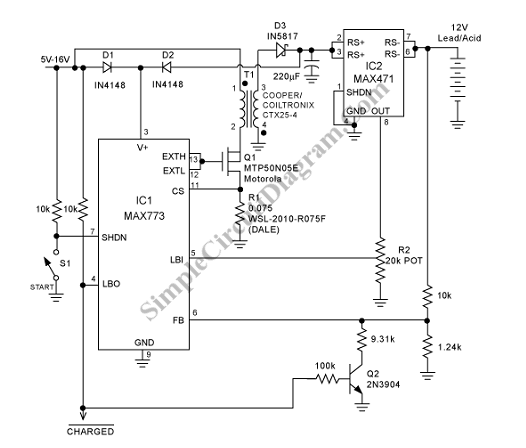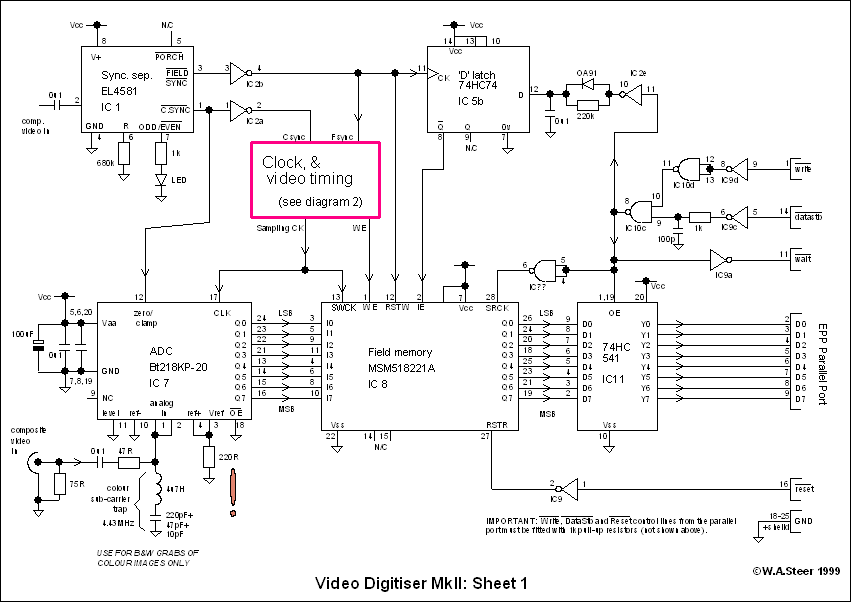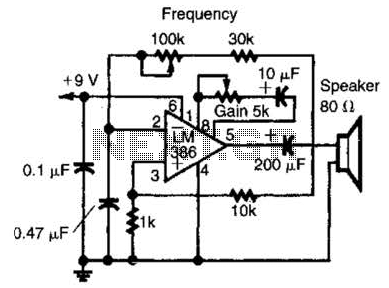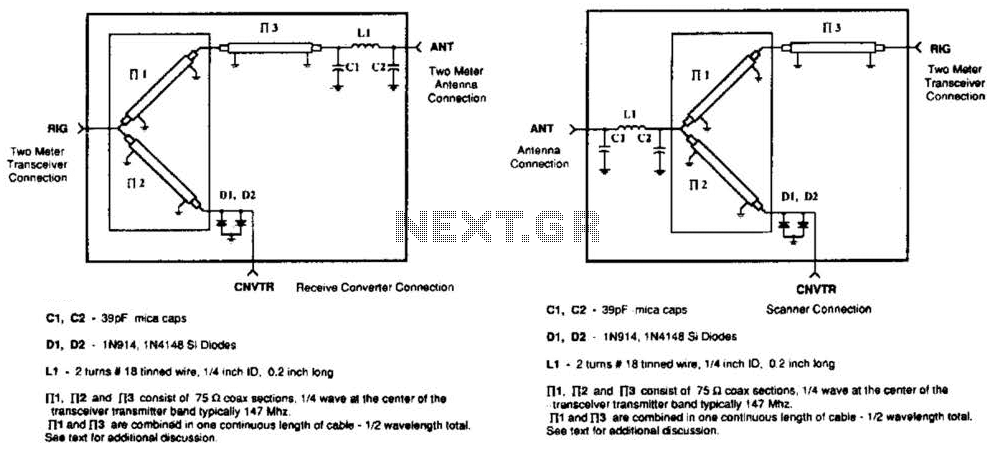
Integrated digital volume potentiometer circuit
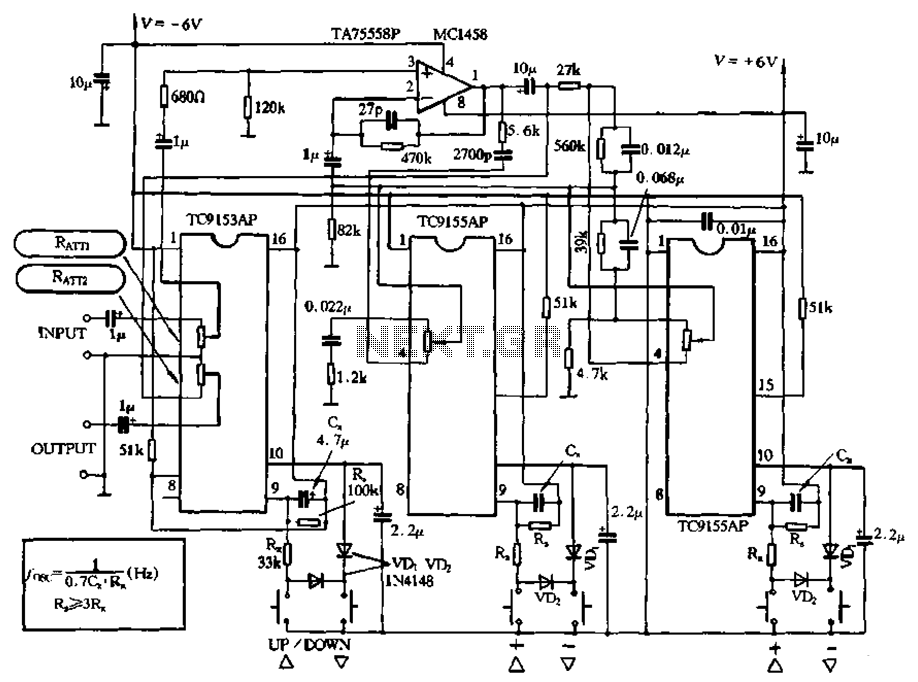
Figure 4-18 illustrates a volume potentiometer T (Xi 153AP) and a tone potentiometer T (155AP) that make up a volume and tone control circuit. This circuit includes Rx and Cx as clock oscillation elements, with values selectable based on the desired oscillation frequency, calculated using the formula: f (Hz) = 0.7F x Cx. The adjustment method for the Guardian 153AP utilizes attenuation levels, with a total adjustment range of 0-66dB and a unit step attenuation of 2dB, where a 10dB attenuation corresponds to a resistance value of 50kΩ (RATT1). The second level of attenuation reduces by 2dB, corresponding to a resistance value of 20kΩ (RATT2). The circuit features two internal LC networks for left and right channels, ensuring a good signal-to-noise ratio through input adjustments with RATT1 and RATT2. The TC9155AP contains two identical circuits, each with an adjustment range of -6 to +6dB and a resistance value of 100kΩ, offering 13-step adjustments. Each channel is equipped with a two-channel electronic potentiometer resistor network connected to an external capacitor in the feedback loop of the operational amplifier. The tone control circuit is constructed using a feedback operational amplifier such as the TA75558P or MC1458, or similar operational amplifiers.
The volume and tone control circuit depicted in Figure 4-18 is designed to facilitate precise audio signal manipulation. The use of potentiometers Xi 153AP and 155AP allows for seamless adjustment of volume and tone, catering to user preferences in audio output. The oscillation frequency is determined by the clock elements Rx and Cx, which are integral for ensuring the stability of the circuit's operation. The formula provided for frequency calculation highlights the relationship between capacitance and frequency, enabling users to select appropriate values based on their specific requirements.
The attenuation levels are crucial for managing signal strength, with the Guardian 153AP providing a broad adjustment range. The specific resistance values associated with each attenuation step facilitate predictable changes in audio output, enhancing user control over the listening experience. The dual-channel configuration ensures that both left and right audio signals can be adjusted independently while maintaining a favorable signal-to-noise ratio, which is essential for high-fidelity audio reproduction.
The TC9155AP's design further enhances this circuit's capabilities by integrating dual identical circuits, allowing for fine-tuning of audio signals across a wider dynamic range. The inclusion of a 13-step adjustment mechanism provides users with granular control over audio output, enabling precise tailoring of sound characteristics.
The operational amplifier feedback loop, formed by connecting the electronic potentiometer network with an external capacitor, plays a vital role in the tone control circuit. The choice of operational amplifiers, such as the TA75558P or MC1458, is critical, as these components are known for their low noise and high performance in audio applications. This configuration ultimately results in an efficient and effective audio processing circuit, suitable for various audio applications, from consumer electronics to professional audio equipment.Figure 4-18 by volume potentiometer T (Xi 153AP and tone potentiometer T ( 155AP consisting of volume, tone control circuit circuit, Rx, cx clock oscillation element, the value of which can be selected according to the desired oscillation frequency : f (Fic L/. 0.7F xCx (Hz) where Rs 3Rxo Guardian 153AP adjustment method using the attenuation levels, the total attenuation adjustment range of O-66dB, unit step attenuation amount of the attenuation level which 2dBo use 10dB attenuation amount units (corresponding to the resistance value of 50 snapped that RATT1); the second level attenuation minus 2dB units using the amount of attenuation (corresponding to the resistance value 20kfl, namely RATT2) o have the same circuit two inner lc, respectively for left and right channel use. to obtain good signal to noise ratio can be used to input RArTl, RATI2 for output. TC9155AP built two identical circuits each t is an adjustment range of 6 ~ + 6dB, the resistance value of is 100kn, sub -level 13 step adjustment, each with a set of two-channel electronic potentiometer resistor network together with an external capacitor connected to the op amp s feedback loop amplifier, tone control circuit composed of feedback operational amplifier using TA75558P also be MC1458 or other similar operational amplifier circuit.
The volume and tone control circuit depicted in Figure 4-18 is designed to facilitate precise audio signal manipulation. The use of potentiometers Xi 153AP and 155AP allows for seamless adjustment of volume and tone, catering to user preferences in audio output. The oscillation frequency is determined by the clock elements Rx and Cx, which are integral for ensuring the stability of the circuit's operation. The formula provided for frequency calculation highlights the relationship between capacitance and frequency, enabling users to select appropriate values based on their specific requirements.
The attenuation levels are crucial for managing signal strength, with the Guardian 153AP providing a broad adjustment range. The specific resistance values associated with each attenuation step facilitate predictable changes in audio output, enhancing user control over the listening experience. The dual-channel configuration ensures that both left and right audio signals can be adjusted independently while maintaining a favorable signal-to-noise ratio, which is essential for high-fidelity audio reproduction.
The TC9155AP's design further enhances this circuit's capabilities by integrating dual identical circuits, allowing for fine-tuning of audio signals across a wider dynamic range. The inclusion of a 13-step adjustment mechanism provides users with granular control over audio output, enabling precise tailoring of sound characteristics.
The operational amplifier feedback loop, formed by connecting the electronic potentiometer network with an external capacitor, plays a vital role in the tone control circuit. The choice of operational amplifiers, such as the TA75558P or MC1458, is critical, as these components are known for their low noise and high performance in audio applications. This configuration ultimately results in an efficient and effective audio processing circuit, suitable for various audio applications, from consumer electronics to professional audio equipment.Figure 4-18 by volume potentiometer T (Xi 153AP and tone potentiometer T ( 155AP consisting of volume, tone control circuit circuit, Rx, cx clock oscillation element, the value of which can be selected according to the desired oscillation frequency : f (Fic L/. 0.7F xCx (Hz) where Rs 3Rxo Guardian 153AP adjustment method using the attenuation levels, the total attenuation adjustment range of O-66dB, unit step attenuation amount of the attenuation level which 2dBo use 10dB attenuation amount units (corresponding to the resistance value of 50 snapped that RATT1); the second level attenuation minus 2dB units using the amount of attenuation (corresponding to the resistance value 20kfl, namely RATT2) o have the same circuit two inner lc, respectively for left and right channel use. to obtain good signal to noise ratio can be used to input RArTl, RATI2 for output. TC9155AP built two identical circuits each t is an adjustment range of 6 ~ + 6dB, the resistance value of is 100kn, sub -level 13 step adjustment, each with a set of two-channel electronic potentiometer resistor network together with an external capacitor connected to the op amp s feedback loop amplifier, tone control circuit composed of feedback operational amplifier using TA75558P also be MC1458 or other similar operational amplifier circuit.
